More on Haswell: Core i5-4670K, Core i5-4670, Core i5-4570 and Core i5-4430 Processors Review

Let’s meet the entire lineup of fourth generation desktop Core i5 processors based on the new Intel Haswell microarchitecture in our new extensive performance review.
Desktop PC users have had few reasons for joy recently. The market is stagnating, so the manufacturers turn to other fields, disappointing loyal fans of the classic desktop computer. One of the latest examples of such a disappointment is Intel’s Haswell microarchitecture. Despite the developer’s claims, the new generation of Intel CPUs is very dubious in its desktop implementation. The Haswell was developed for mobile and ultra-mobile applications in the first place, so it is really good for portable computers and doesn’t suit classic desktop configurations well enough. You can refer to our special review for details. In brief, the Haswell-based desktop CPUs are not much faster than their Ivy Bridge predecessors but require a new platform with a new CPU socket. They consume more power and have lower overclocking potential. All of this can hardly entice you into a hardware upgrade, so the whole Haswell story only serves to prove that it is not quite appropriate to use a mobile CPU design for desktop products.
Well, Intel doesn’t seem to care much about the opinion of desktop PC enthusiasts. The market trends go the opposite way and we have to put up with the Haswell anyway. Moreover, this microarchitecture seems to be meant for a longer lifecycle than its predecessors. As far as we know, the Broadwell microarchitecture, which is going to replace the Haswell and transition to 14nm tech process, will not be used in desktop CPUs at all. Instead, Intel will just release a new chipset series, compatible with existing Haswell-based CPUs, to modernize the platform without redesigning it. It looks like we’ll only see a new design of desktop CPUs in 2015. That’s when the Skylake microarchitecture is planned to be introduced.
So it turns out the Haswell just cannot be ignored. People will have to build computers with Haswell CPUs and we, on our part, cannot neglect our duty of reviewing them. In our first review we covered the senior desktop Haswell-based product – Core i7-4770K. It is a rather expensive processor priced at over $300. The Core i5 series is targeted at a broader audience. It is cheaper but not much worse in its specs. The fundamental difference of the Core i5 series from the Core i7 is the lack of Hyper-Threading. Otherwise, the Core i5 looks very good with four x86 cores and clock rates comparable to those of the Core i7. The difference in the amount of L3 cache (6 MB as opposed to 8 MB in the Core i7) doesn’t show up in practice as we know from our tests of previous-generation CPUs.
Thus, we didn’t have to think long about the topic of our second review of Haswell CPUs. Today, we are going to tell you about the Core i5 series based on the Haswell design which includes four regular desktop Core i5 models (there are also seven specific S, T and R-indexed models we’ll discuss some other time).
Closer Look at 4th Generation Intel Core i5 Processors
The model range of desktop Haswell-based processors is hardly different from the Ivy Bridge series. Like with the Core i7 series, the new microarchitecture doesn’t bring about any change in terms of clock rates, let alone other basic specs. You can easily see that in the table below (we don’t include the special S, T, and R-indexed Core i5 models in it for the sake of readability).
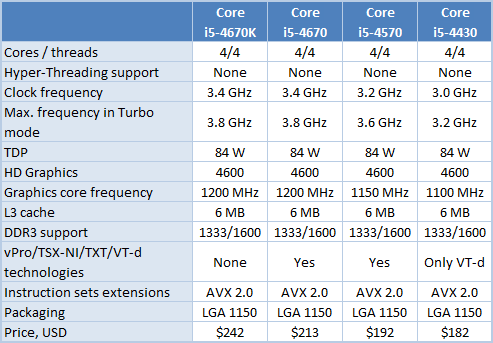
The updated Core i5 series includes only four models. The fifth modification, Core i5-4440, is going to be added later on. Overall, Intel intends to limit the variation so that there were just two models in each price category. That’s why it is impossible to find direct predecessors for the Haswell-based Core i5 CPUs in the Ivy Bridge series. More importantly, the Core i5 4000 series doesn’t include any models without an integrated graphics core.
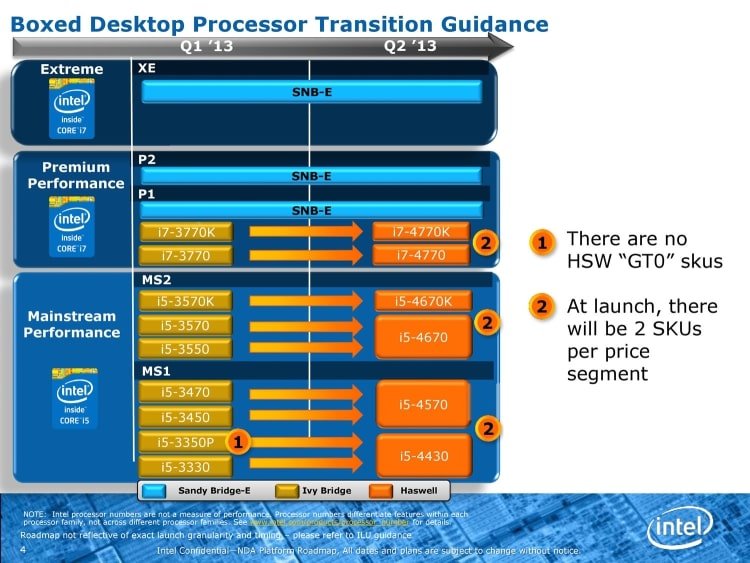
Anyway, the Core i5 remains the most attractive offer for users who want to have a quad-core CPU at a reasonable price. The Haswell-based Core i5 CPUs resemble their Core i7 cousins, featuring the same 22nm semiconductor die (177 sq. mm large), but they are slower due to lower clock rates, smaller L3 cache (6 instead of 8 MB), and lack of Hyper-Threading.
The senior model in the updated Core i5 series is overclocker-friendly, which is denoted by the K index. The Core i5-4670K supports a full range of unlocked frequency multipliers and allows to overclock its x86 cores, L3 cache and memory controller. If you don’t want to pay extra for these capabilities, the Core i5-4670 model is exactly the same, minus the overclocking features. The Core i5-4670 and Core i5-4570 models may also be interesting for their support of certain security technologies (vPro, TXT and VT-d) which are missing in the K-indexed Haswell-based CPUs (in the Core i7-4770K, too). The Core i5-4430 doesn’t support vPro and TXT, either, and its lower market positioning is also reflected in its Turbo Boost 2.0 setup. While the rest of the Core i5 CPUs can dynamically increase their clock rate by 400 MHz above the specified level, the Core i5-4430 can only do that by 200 MHz.
By the way, the term “specified clock rate” loses its meaning with the Turbo Boost 2.0 technology. The Core i5-4430 is the only model that can work at its specified clock rate whereas the other Core i5 models work 200 MHz faster than specified even at full load. There’s nothing new about that, actually. Turbo Boost 2.0 did the same with the Ivy Bridge generation.
We can easily find similarities between the specs of the Haswell and Ivy Bridge based Core i5 processors. The transition to the new CPU design hasn’t provoked any increase in clock rate or cache memory amount. That’s why the Core i5-4670K and Core i5-4670 have almost the same specs as the Core i5-3570K and Core i5-3570 whereas the Core i5-4570 and Core i5-4430 models are very much alike to the Core i5-3470 and Core i5-3330. On the other hand, the newer microarchitecture can be identified by the 7 W higher TDP, support for the AVX 2.0 instruction set, and the more advanced HD Graphics 4000 core with 20 execution devices.
So when it comes to computing performance, the Core i5 4000 series are going to be superior to their predecessors through certain improvements on the microarchitectural level. There are not so many of them, yet they have an impact.
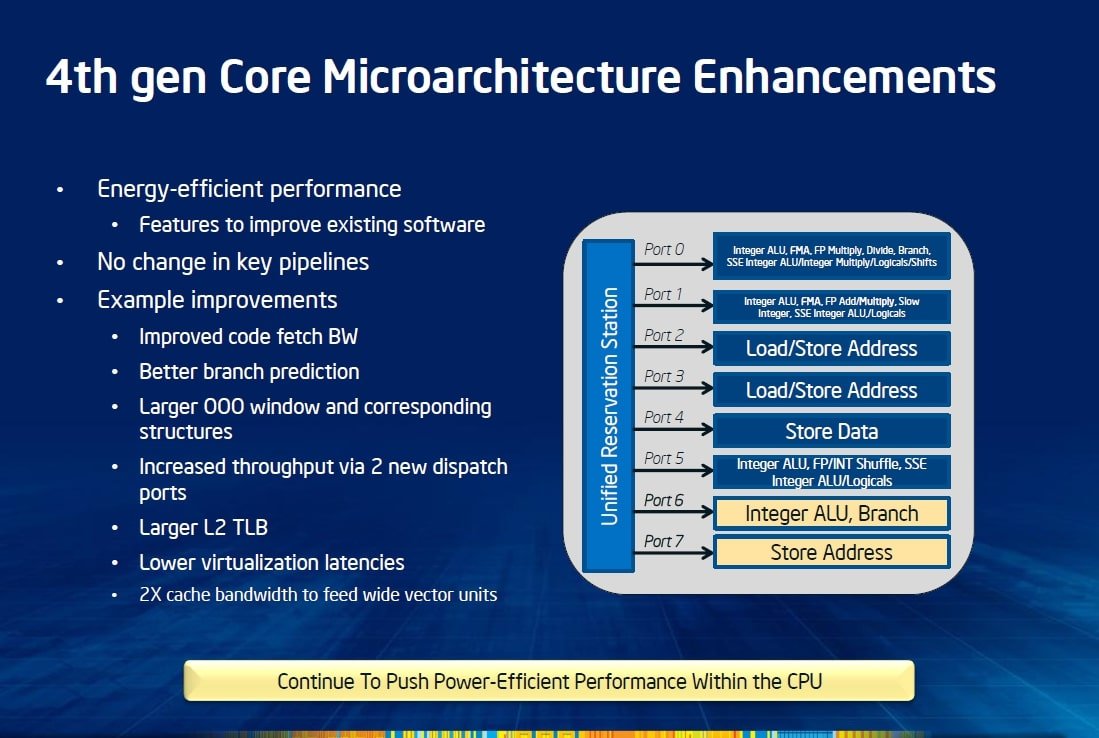
First of all, branch prediction algorithms have been improved in the front part of the execution pipeline. The improvement is achieved by means of larger internal buffers and data structures in nearly all of the CPU’s subunits. The out-of-order execution window has been enlarged, so instructions from a single thread can be processed more efficiently in parallel to make fuller use of the CPU’s execution devices. For the first time since 2006 the number of execution ports is increased in the Haswell. There are 8 instead of 6 such ports now, so the theoretical throughput of the Haswell’s pipeline has increased by a fourth. Intel has also expanded the instruction set, adding AVX2. Included into the new subset are FMA instructions that perform two floating-point operations simultaneously. Thanks to them, the Haswell’s theoretical floating-point performance is doubled. To eliminate any potential bottlenecks, the L1 and L2 cache bandwidth is doubled as well.
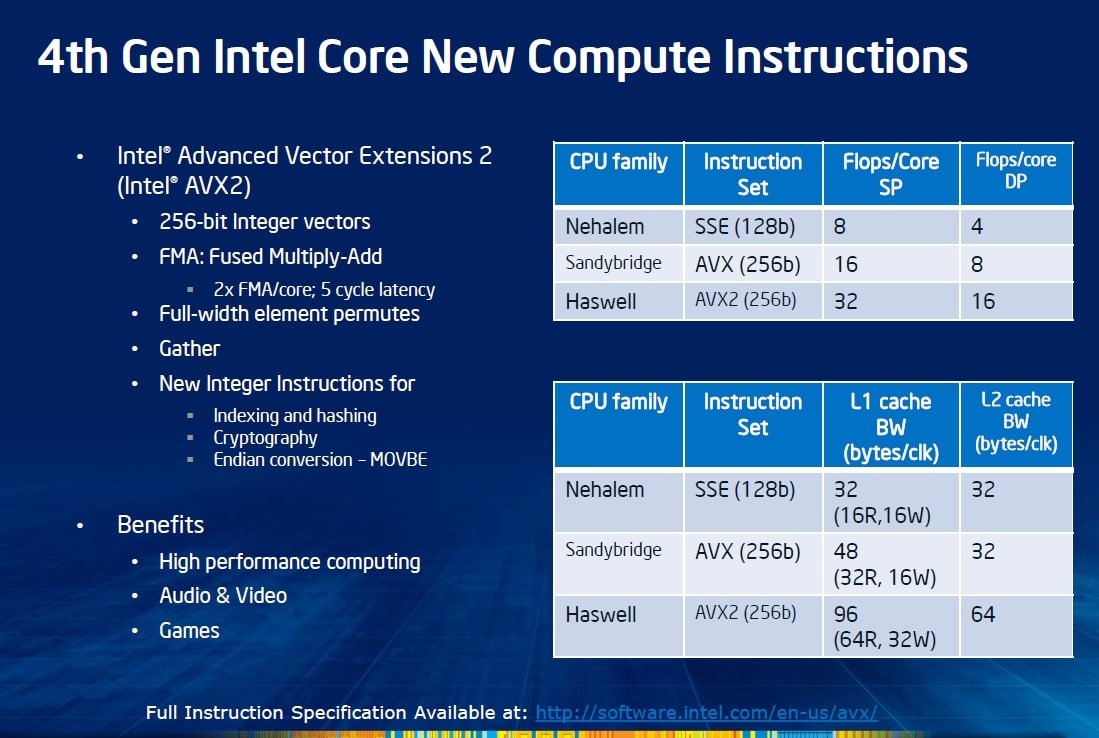
Intel doesn’t differentiate its desktop Haswell-based CPUs in terms of the integrated graphics core. All regular Core i7 and Core i5 models are equipped with the GT2 core. Graphics of this class used to be only implemented in Intel’s K-indexed CPUs whereas the rest were equipped with the weaker GT1. But now you can choose any LGA1150 processor for a computer without a discrete graphics card and you’ll have the same graphics performance. This also refers to the Core i3 series which is to be announced in September.
Testbed Configuration and Testing Methodology
We’ve collected all four basic Haswell-based Core i5 models for this testing. We are going to compare them with the Ivy Bridge generation represented by the most popular and interesting models: Core i5-3570K and Core i5-3470. Moreover, we’ll throw in a Core i5-2550K from the Sandy Bridge generation in order to show you the progress Intel has made in the last years. In other words, you will be able to compare three generations of Intel CPUs in the diagrams below.
We also include a couple of higher-class CPUs: Core i7-3770K and Core i7-4770K. They’ll show you how much you can gain by choosing a more expensive product.
As for AMD, we can only take AMD’s FX-8350, the senior model for the Socket AM3+ platform, because the rest of AMD’s products are much cheaper than the Core i5 series after the recent price cut. AMD just has no illusions left about pitting its eight-core processor against Intel’s Core i7 or Core i5.
As a result, our testbeds were built with the following hardware and software components:
- Processors:
- AMD FX-8350 (Vishera, 8 cores, 4.0-4.2 GHz, 4 x 2 MB L2, 8 MB L3);
- Intel Core i7-4770K (Haswell, 4 cores + HT, 3.5-3.9 GHz, 4 x 256 KB L2, 8 MB L3);
- Intel Core i5-4670K (Haswell, 4 cores, 3.4-3.8 GHz, 4 x 256 KB L2, 6 MB L3);
- Intel Core i5-4670 (Haswell, 4 cores, 3.4-3.8 GHz, 4 x 256 KB L2, 6 MB L3);
- Intel Core i5-4570 (Haswell, 4 cores, 3.2-3.6 GHz, 4 x 256 KB L2, 6 MB L3);
- Intel Core i5-4430 (Haswell, 4 cores, 3.0-3.2 GHz, 4 x 256 KB L2, 6 MB L3);
- Intel Core i7-3770K (Ivy Bridge, 4 cores + HT, 3.5-3.9 GHz, 4 x 256 KB L2, 8 MB L3);
- Intel Core i5-3570K (Ivy Bridge, 4 cores, 3.4-3.8 GHz, 4 x 256 KB L2, 6 MB L3);
- Intel Core i5-3470 (Ivy Bridge, 4 cores, 3.2-3.6 GHz, 4 x 256 KB L2, 6 MB L3);
- Intel Core i5-2550K (Sandy Bridge, 4 cores, 3.4-3.8 GHz, 4 x 256 KB L2, 6 MB L3).
- Processor cooler: NZXT Havik 140.
- Mainboards:
- ASUS Crosshair V Formula (Socket AM3+, AMD 990FX + SB950);
- ASUS P8Z77-V Deluxe (LGA 1155, Intel Z77 Express);
- Gigabyte Z87X-UD3H (LGA 1150, Intel Z87 Express).
- Memory: 2 x 8 GB DDR3-2133 SDRAM, 9-11-11-31 (G.Skill [TridentX] F3-2133C9D-16GTX).
- Graphics card: NVIDIA GeForce GTX 680 (2 GB/256-bit GDDR5, 1006/6008 MHz).
- Storage sub-system: Intel SSD 520 240 GB (SSDSC2CW240A3K5).
- Power supply unit: Corsair AX760i (80 Plus Platinum, 760 W).
- Operating system: Microsoft Windows 8 Enterprise x64;
- Drivers:
- Intel Chipset Driver 9.4.0.1017;
- Intel Graphics Media Accelerator Driver 15.31.3.64.3071;
- Intel Management Engine Driver 9.5.0.1345;
- Intel Rapid Storage Technology 12.5.0.1066;
- NVIDIA GeForce 320.49 Driver.
We will use a discrete graphics card Nvidia GeForce GTX 680 for our tests, so the performance of Intel’s new integrated graphics core is not covered in this review. You can refer to our special review about the Intel HD Graphics 4600 instead.
Performance
General Performance
As usual, we use Bapco SYSmark 2012 suite to estimate the processor performance in general-purpose tasks. It emulates the usage models in popular office and digital content creation and processing applications. The idea behind this test is fairly simple: it produces a single score characterizing the average computer performance. After the launch of Windows 8 SYSmark 2012 got updated to version 1.5, and this is exactly the version e are using in our test session.
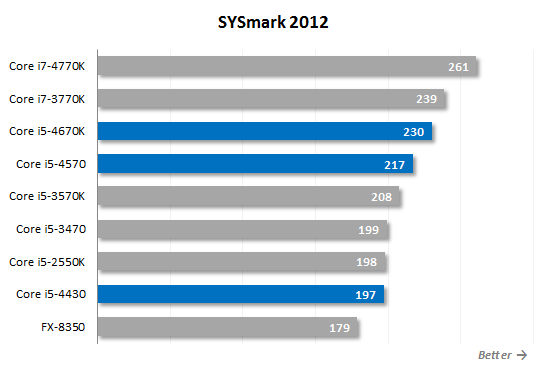
The microarchitectural improvements implemented in the Haswell design lead to a clear advantage of the new Core i5 over their 3000 series predecessors even at the same clock rates. This advantage amounts to about 10%, which is comparable to the gap between the Core i7-4770K and Core i7-3770K we saw in our earlier tests. This makes the flagship Core i5 with Ivy Bridge design comparable only to the midrange Haswell-based Core i5 models: the Core i5-3570K falls behind the Core i5-4570. This is no breakthrough, though. The new Core i5 are just a little faster than the older ones. For example, the newest Core i5-4670K is only 16% faster than the old Core i5-2550K, which is hardly much progress considering the gap of two generations between them. On the other hand, Intel can afford to update its CPU families in such a relaxed way since there is competition from AMD. AMD’s topmost FX-8350 processor fails to catch up with the Core i5-4430, the junior quad-core Haswell!
Let’s take a closer look at the performance scores SYSmark 2012 generates in different usage scenarios. Office Productivity scenario emulates typical office tasks, such as text editing, electronic tables processing, email and Internet surfing. This scenario uses the following applications: ABBYY FineReader Pro 10.0, Adobe Acrobat Pro 9, Adobe Flash Player 10.1, Microsoft Excel 2010, Microsoft Internet Explorer 9, Microsoft Outlook 2010, Microsoft PowerPoint 2010, Microsoft Word 2010 and WinZip Pro 14.5.
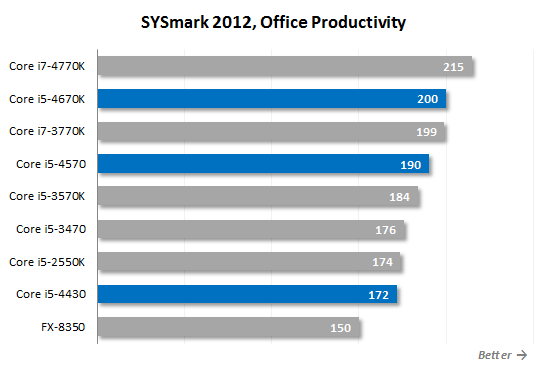
Media Creation scenario emulates the creation of a video clip using previously taken digital images and videos. Here they use popular Adobe suites: Photoshop CS5 Extended, Premiere Pro CS5 and After Effects CS5.
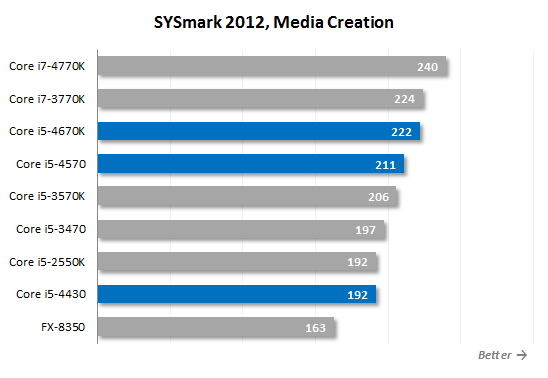
Web Development is a scenario emulating web-site designing. It uses the following applications: Adobe Photoshop CS5 Extended, Adobe Premiere Pro CS5, Adobe Dreamweaver CS5, Mozilla Firefox 3.6.8 and Microsoft Internet Explorer 10.
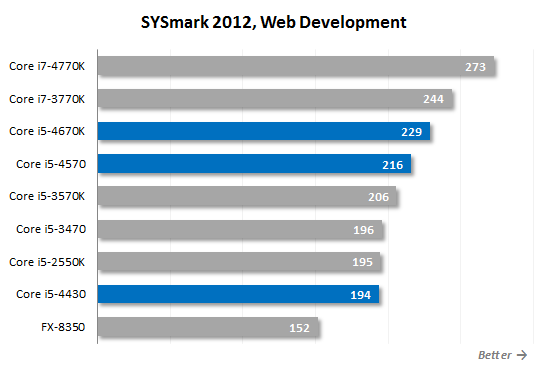
Data/Financial Analysis scenario is devoted to statistical analysis and prediction of market trends performed in Microsoft Excel 2010.
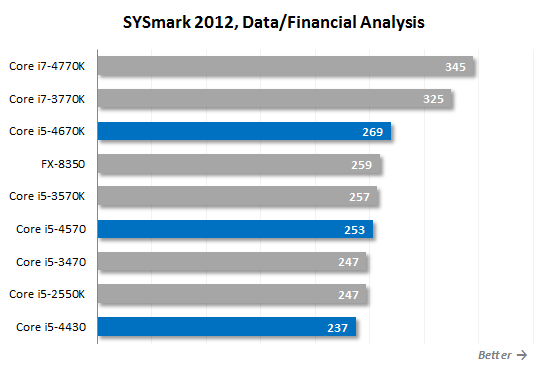
3D Modeling scenario is fully dedicated to 3D objects and rendering of static and dynamic scenes using Adobe Photoshop CS5 Extended, Autodesk 3ds Max 2011, Autodesk AutoCAD 2011 and Google SketchUp Pro 8.
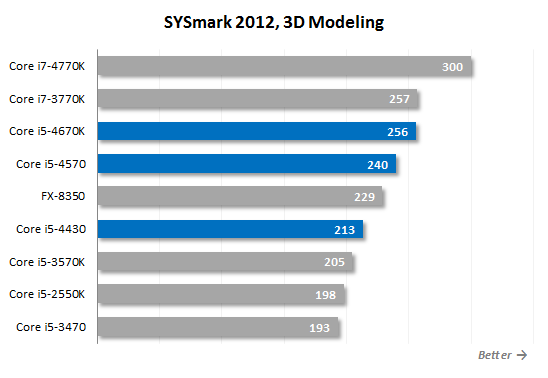
The last scenario called System Management creates backups and installs software and updates. It involves several different versions of Mozilla Firefox Installer and WinZip Pro 14.5.
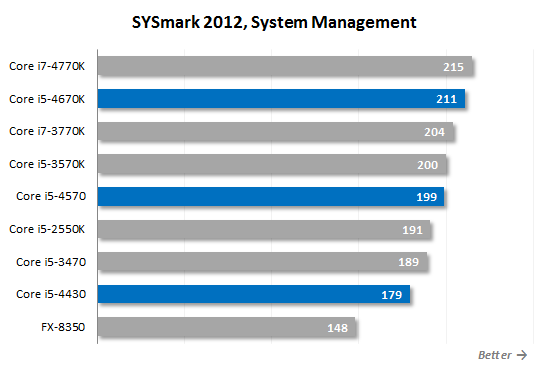
We can note that the Haswell microarchitecture enjoys its maximum advantage over the Ivy Bridge in the 3D Modeling scenario. The new Core i5 are more than 20% ahead of their predecessors there, suggesting that the new CPU design is more optimal for loads that can be processed in parallel. As a result, the Core i5-4670K is as fast as the Core i7-3770K, the senior LGA1155 processor of the previous generation, not only at single-threaded loads (where Hyper-Threading’s effect is small) but at other loads as well. The Haswell looks good in four scenarios: System Management, Media Creation, Office Productivity and 3D Modeling.
We shouldn’t overestimate the benefits of the new microarchitecture, though. The Core i7 and Core i5 processors of different generations are comparable just because the Core i7 and Core i5 series do not differ much in their specs. Anyway, that’s an argument in favor of the new Core i5: they can often deliver the same performance as the more expensive 1-year-old CPUs at different computing loads.
Gaming Performance
As you know, it is the graphics subsystem that determines the performance of the entire platform equipped with pretty high-speed processors in the majority of contemporary games. Therefore, we select the most CPU-dependent games and take the fps readings twice. The first test run is performed without antialiasing and in far not the highest screen resolutions. These settings allow us to determine how well the processors can cope with the gaming loads in general and how the tested CPUs will behave in the nearest future, when new faster graphics card models will be widely available. The second pass is performed with more real-life settings – in FullHD resolution and maximum FSAA settings. In our opinion, these results are less interesting, but they demonstrate clearly the level of performance we can expect from contemporary processors today.
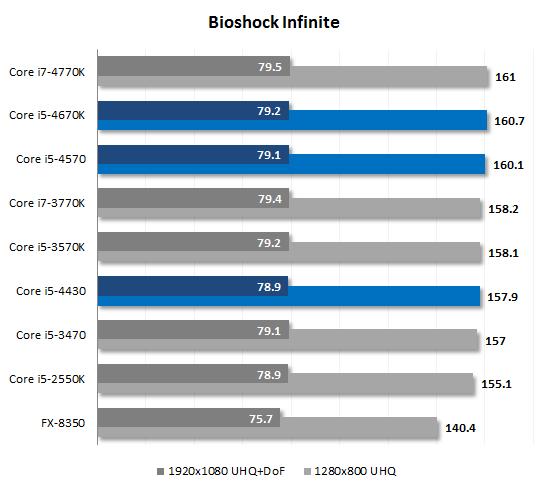
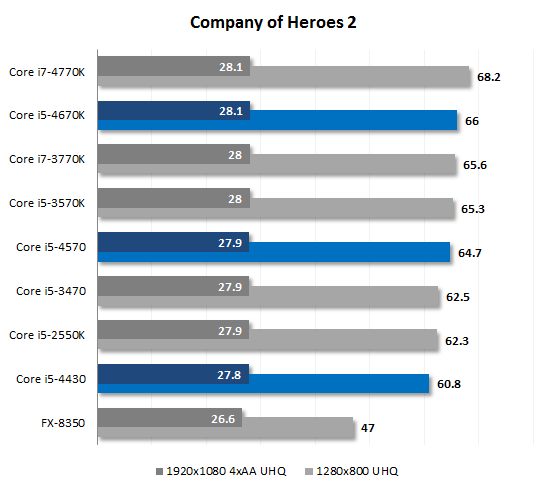
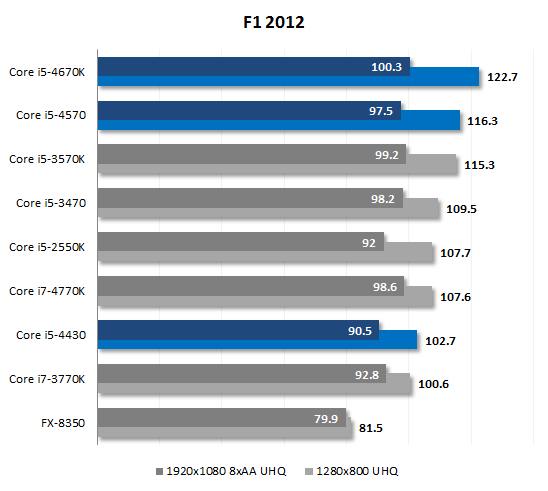
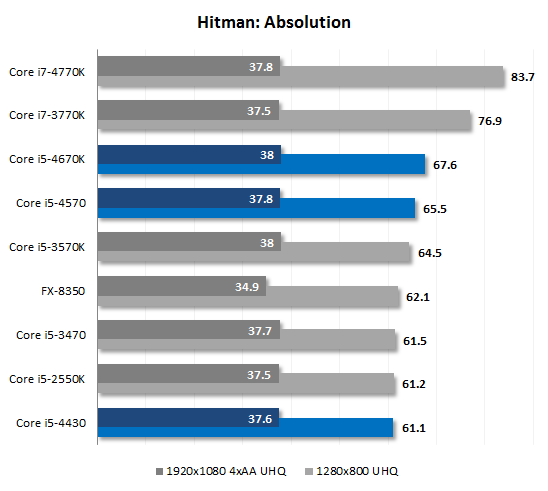
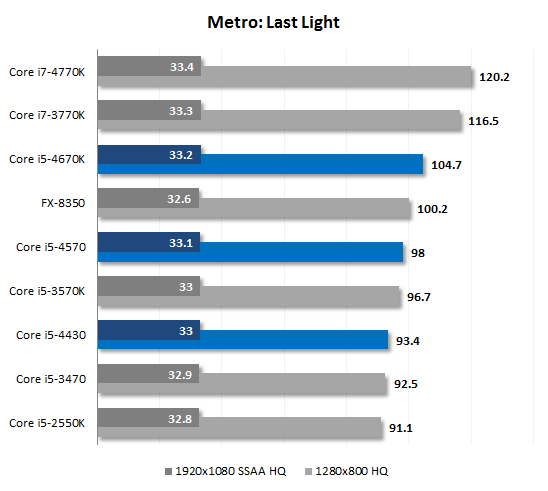
We’ve always regarded Core i5 series CPUs as a good choice for building a high-performance gaming computer. The transition to the Haswell microarchitecture doesn’t change anything in this respect. They are fast enough to accompany a modern graphics card, so the frame rates are almost the same in most games in the Full-HD resolution. It means the frame rate is limited by the graphics card rather than by the CPU. As for their perspectives in future applications, the low-resolution results suggest that the Haswell generation is somewhat better than the Ivy Bridge or Sandy Bridge. However, the senior LGA1150 processor Core i7-4770K is still better than the Core i5-4670K. Many recently released shooters, e.g. Metro: Last Light and Hitman: Absolution, support multithreading, so the Core i7 enjoys an advantage thanks to its Hyper-Threading technology. There are also examples to the contrary, though. Hyper-Threading has a negative effect in the racing sim F1 2012 where the Core i7 series are inferior to their less expensive cousins.
We’ll finish our gaming tests by running the popular synthetic benchmark 3DMark Fire Strike.
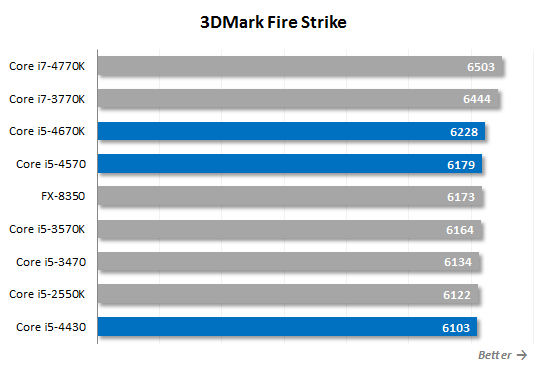
The diagram sums up what we’ve seen above in the games. The Core i7 series have higher gaming potential than the Core i5. As for the Core i5 model range, all of them are the same in terms of gaming, despite their differences in microarchitecture and clock rates. So, 3D games can hardly be a reason to upgrade from Intel’s older to newer quad-core CPUs.
Performance in Applications
The first diagram shows one of the intermediate results of the Futuremark 3DMark11 Fire Strike – Physics Score benchmark. This parameter shows how fast the testing participants can cope with a special physics test emulating the behavior of a complex system with a large number of objects.
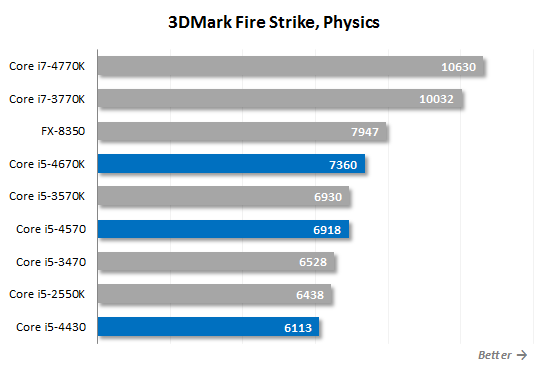
These results can be explained easily. The benchmark is multithreaded, so the Core i7 series with Hyper-Threading technology and the 8-core FX-8350 are ranked higher than the Core i5 CPUs. The Haswell-based Core i5 look good, though. Considering that there is no increase in clock rates over the last-year Core i5 models, the 6% increase in performance is only due to microarchitecture improvements. Thanks to them, the Core i5-4570 can deliver the same performance as the Core i5-3570K. The junior Core i5-4430 cannot match the Core i5-3470, though.
To test the processors performance during data archiving we resort to WinRAR 5.0 archiving utility. Using maximum compression rate we archive a folder with multiple files with 1.7 GB total size.
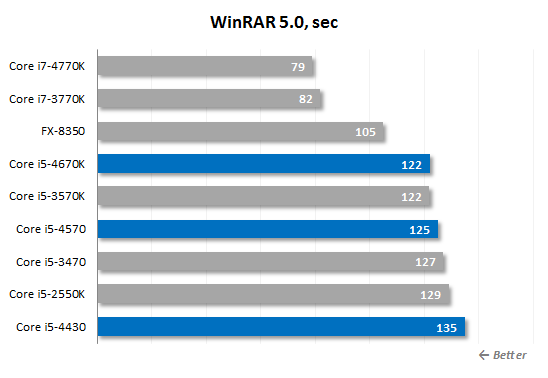
The latest version of the WinRAR archiver is optimized for multithreading, so the Core i7 series enjoy a 50% advantage over their Core i5 cousins. AMD’s 8-core FX-8350 is among the leaders, too, as its microarchitecture copes well with multithreaded integer loads. As for the Haswell microarchitecture, it doesn’t accelerate this archiver. The Haswell and Ivy Bridge processors have the same results here if clocked at the same frequencies. The new breed of Intel CPUs isn’t much faster than the Sandy Bridge series, either.
The processor performance in cryptographic tasks is measured using a built-in benchmark of the popular TrueCrypt utility that uses AES-Twofish-Serpent “triple” encryption. I have to say that this utility not only loads any number of cores with work in a very efficient manner, but also supports special AES instructions.
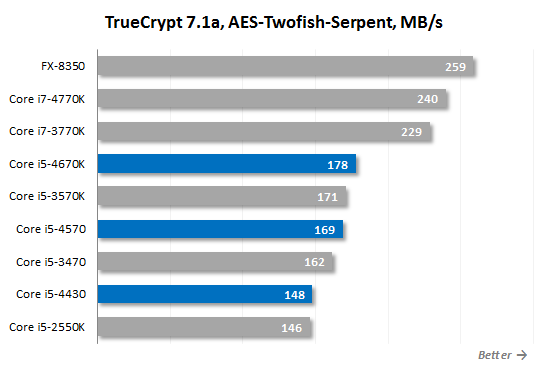
Data encryption is yet another task where the Core i7 series are much better than their cousins which lack Hyper-Threading. The Haswell microarchitecture shows its best here, so the difference between the Core 5 4000 and 3000 CPUs working at the same frequencies amounts to 4%. Compared to the Sandy Bridge, the Core i5-4670K enjoys a 22% advantage over the Core i5-2550K.
The popular scientific computations suite Wolfram Mathematica has been upgraded to version 9, so we again have it among our tests. We use its integrated benchmark MathematicaMark9.
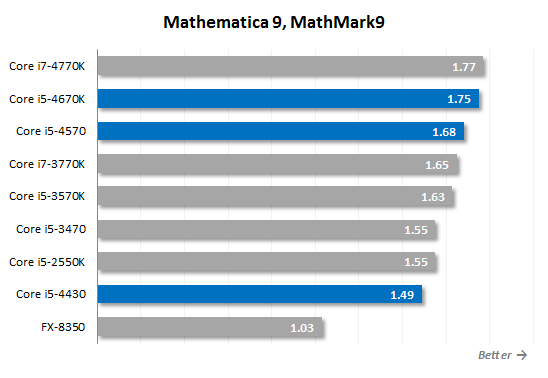
The Haswell microarchitecture makes the new CPUs about 7% faster than their predecessors working at the same clock rate. Considering that not all of the Mathematica algorithms can be executed in parallel, that’s enough for the Core i5-4670K and Core i5-4570 to beat the LGA1155 flagship Core i7-3770K. The junior Haswell-based Core i5 isn’t fast here, though. The Core i5-4430 works at a lower clock rate and its Turbo Boost setup is not aggressive. That’s why it has the lowest MathematicaMark9 score among the tested Intel CPUs.
Rightware Browsermark 2.0 will help us evaluate the online performance of our CPUs. The benchmark uses latest web technologies such as JavaScript, HTML5, WebGL, CSS, etc. We launch it in Google Chrome 28.
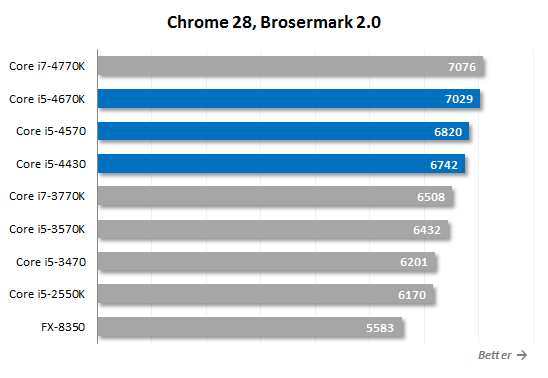
Modern browsers are mostly single-threaded applications, yet this is not the only explanation of the results we see here. Intel’s new microarchitecture ensures a 10% advantage over the Ivy Bridge generation. And since the different CPUs do not differ much in performance within the same generation, the junior Core i5 4000 series product looks better than the Core i5-3570K.
We benchmark CPUs in Adobe Photoshop CS6 using our custom test that is based on the Retouch Artists Photoshop Speed Test and consists of typical processing of four 24-megapixel images captured with a digital camera.
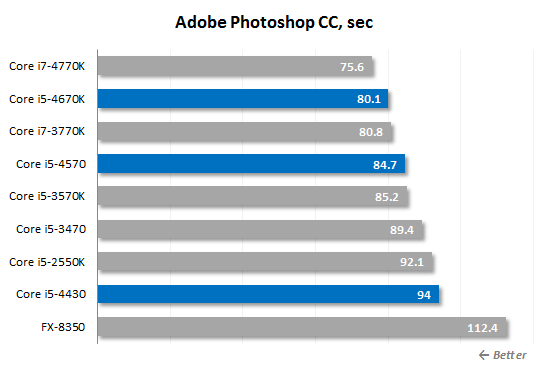
We already noted in our earlier tests that the Haswell doesn’t provide any tangible benefits in Photoshop CS6. The same is true for the newer version of the popular image-editing suite. The Haswell-based products are about 6% faster than the Ivy Bridge series and 15% faster than the Sandy Bridge. The Core i5-4670K is again ahead of the Core i7-3770K, so the LGA1150 platform may be attractive for professional photographers and designers.
The performance in Adobe Premiere Pro CS6 is determined by the time it takes to render a Blu-ray project with a HDV 1080p25 video into H.264 format and apply different special effects to it.
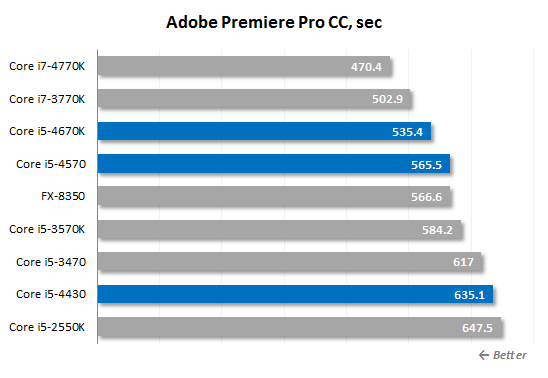
Processing HD video content is a task that can be effectively executed in parallel on multiple CPU cores. As we noted above, the Haswell microarchitecture is perfect for such usage scenarios. That’s why the Core i5-4670K is 9% faster than the Core i5-3570K. Moreover, the senior Ivy Bridge Core i5 model is beaten by the Core i5-4570, which is a midrange Haswell. The junior model of the new series, Core i5-4430, is only capable of competing with the Core i5-2550K, though.
Performance in Adobe After Effects CC is measured as the time it takes to render a predefined 3D video using classic approach and to apply a set of filters and effects to it.
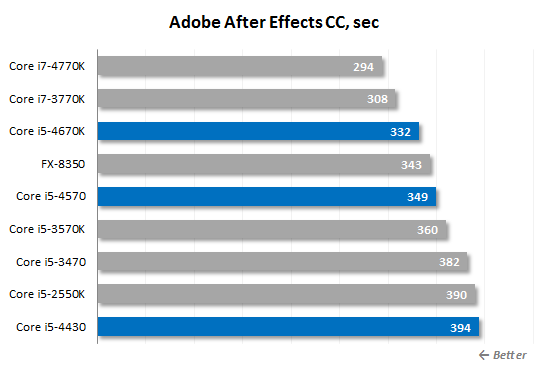
Like Premier Pro, the After Effects application can effectively run on multiple CPU cores, so the Haswell-based CPUs can show their best and outperform their predecessors by about 8%. The Core i7-3770K is about 8% ahead of the Core i5-4670K, though. It means that the benefits of the new microarchitecture cannot outweigh the benefits of Hyper-Threading. AMD’s 8-core FX-8350 is good at processing video, too. It is about as fast as the midrange models of the new Core i5 series.
In order to measure how fast our testing participants can transcode a video into H.264 format we used x264 FHD Benchmark 1.0.1 (64 bit). It works with an original MPEG-4/AVC video recorded in 1920×1080@50fps resolution with 30 Mbps bitrate and measures the time it takes x264 r2334 coder to convert the video. I have to say that the results of this test are of great practical value, because the x264 codec is also part of numerous popular transcoding utilities, such as HandBrake, MeGUI, VirtualDub, etc. We occasionally update the coder used in this performance test. This time we used version r2345, which supports all contemporary instruction sets including AVX2.
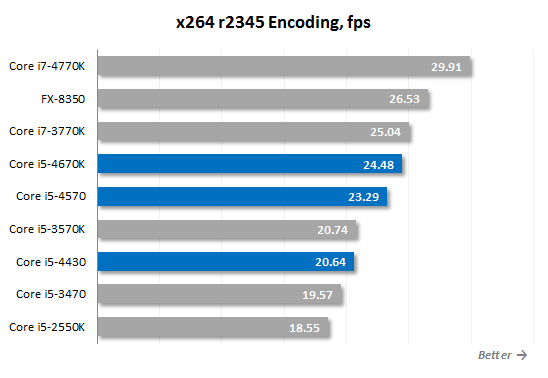
Considering that the x264 codec uses the newest instructions introduced in the Haswell microarchitecture, we shouldn’t be surprised at their advantage over the older CPUs. For example, the Core i5-4670K is as much as 18% faster than the Core i5-3570K which works at the same clock rate. The junior Core i5-4430 is comparable to the best of the previous-generation Core i5 CPUs as the result. So, Haswell CPUs have huge potential and it’s up to programmers to make full use of it. On the other hand, the updated Core i5 series cannot match the Core i7-3770K with its Hyper-Threading. They are also slower than the AMD FX-8350 which is very good at processing video content.
We will test mental ray rendering speeds on a specially prepared complex scene in Autodesk 3ds max 2014:
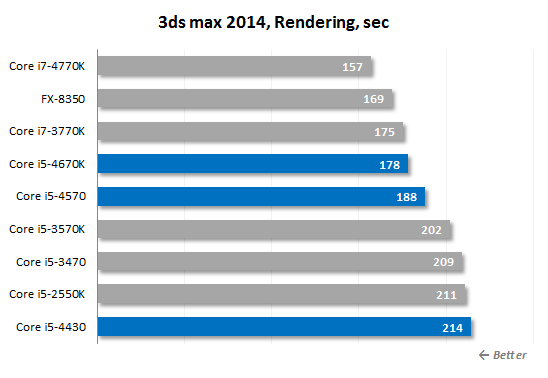
The Haswell’s improvements ensure a 13% performance boost for the final rendering in 3ds max 2014. As a result, most of the Core i5 4000 series CPUs are faster than their predecessors. The Core i5-4670K is almost as fast as the higher-class Core i7-3770K. The junior model Core i5-4430 works at a rather low clock rate and falls behind the Core i5-3470 and Core i5-2550K.
Power Consumption
The Haswell microarchitecture lets Intel manufacture processors with surprisingly low heat dissipation and power consumption which are targeted at the mobile market. Desktop CPUs are a different story, though. The first thing we need from them is performance, so energy efficiency isn’t the main priority. In our tests of Haswell-based Core i7 CPUs, we found them to consume more power than their predecessors at high loads. This is indicated by the increased TDP (84 watts), which is 7 watts higher than before.
Anyway, the overall design of the LGA1150 platform suggests that we can expect better energy efficiency from it than from configurations built out of previous-generation components. A substantial part of the CPU voltage regulator resides in the CPU now, so the mainboard’s power system is simpler. Then, the new chipsets are manufactured on 32nm tech process and consume 4.1 instead of 6.7 watts. That’s why we had some doubts that the high power draw of our Core i7-4770K configuration could be extrapolated to all other Haswell-based platforms.
Therefore, once we got our hands on the entire Core i5 processor lineup based on Haswell design, we decided to pay special attention to the power consumption of platforms built around them. The new digital power supply unit from Corsair – AX760i – allows monitoring consumed and produced electrical power, which we use actively during our power consumption tests. The graphs below (unless specified otherwise) show the full power draw of the computer (without the monitor) measured after the power supply. It is the total power consumption of all the system components. The PSU’s efficiency is not taken into account. The CPUs are loaded by running the 64-bit version of LinX 0.6.4 utility with FMA instructions support (for AMD processors) and AVX instructions support (for Intel processors). Moreover, we enabled Turbo mode and all power-saving technologies to correctly measure computer’s power draw in idle mode: C1E, C6, Enhanced Intel SpeedStep and AMD Cool’n’Quiet.
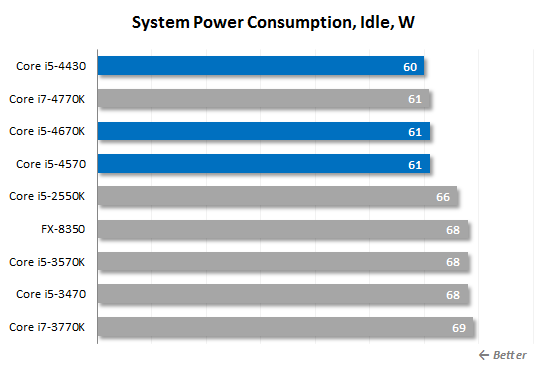
We see a familiar picture in the idle mode: the configurations with Haswell-based CPUs need considerably less power than their opponents.
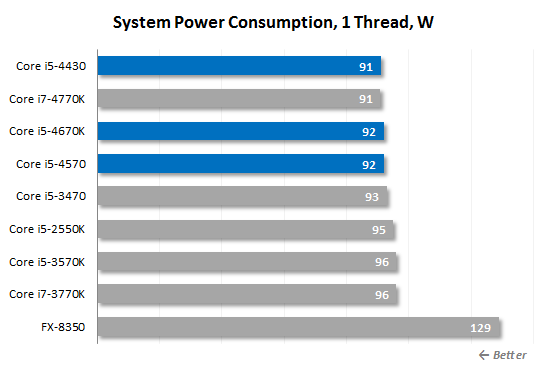
The LGA1150 platform is quite economical when it comes to single-threaded loads. The new Core i7 and Core i5 CPUs need less power than their predecessors or AMD products.
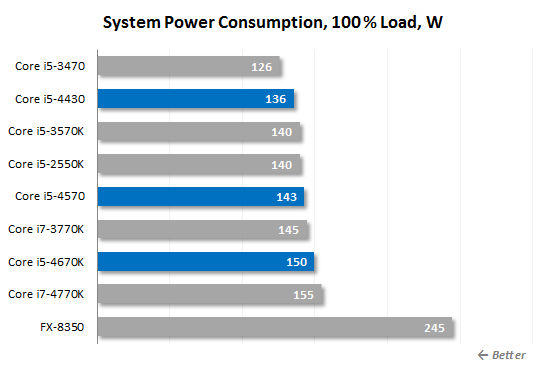
At full load, the Haswell-based configurations require more power than their Ivy Bridge counterparts. The difference isn’t large at only 10 watts. It was larger in our earlier tests when we had engineering samples of CPUs, yet it is still a fact that Haswell CPUs need more power than the Ivy Bridge series at high loads notwithstanding all the power-saving measures taken by Intel. On the other hand, the new CPUs have become faster, so their performance-per-watt is actually comparable to that of their predecessors.
Overclocking
The Haswell generation doesn’t sport high overclocking potential. As we learned earlier, the peak frequencies you can achieve with overclocker-friendly Haswell-based Core i7 CPUs are considerably lower than with previous-generation CPUs. The main reason for that is that the new CPUs get hotter at high loads due to the integration of voltage regulator components without any attempt to ensure more efficient heat transfer. Like with the Ivy Bridge series, there is a rather mediocre thermal interface between the Haswell’s semiconductor die and heat-spreader. The fluxless soldering employed for Sandy Bridge LGA1155 CPUs is now only used to manufacture the expensive products for the LGA2011 platform. Thus, the typical overclocking result you can reach with a Core i7-4770K is 4.4 to 4.5 GHz with a high-performance air cooler. And the CPU cores get very hot, up to critical levels, even after a small increase in CPU voltage.
It is hard to cool overclocked Core i5 CPUs, too, so we can’t expect them to perform much better than their senior cousins. We can hope for a tiny increase in their overclocking potential due to the lack of Hyper-Threading technology, which means lower temperatures at full load. Let’s check this out with a Core i5-4670K which has unlocked frequency multipliers.
After increasing the voltage to 1.25 volts, we overclocked our Core i5-4670K to 4.5 GHz.
Our CPU couldn’t do any better. When we tried to increase its voltage above 1.25 volts, it would overheat. In fact, the CPU was dangerously hot even at 1.25 volts. And if we didn’t change the voltage but raised the clock rate higher, the computer would crash during our stability tests.
Thus, the overclocker-friendly Haswell-based Core i5 is no better in terms of overclocking than its Core i7 cousin. You can hardly expect any quad-core Haswell-based CPU to overclock higher than 4.4 or 4.5 GHz unless you use some special cooling methods or replace the thermal interface between the CPU’s die and heat-spreader.
By the way, apart from the Core i5-4670K, the new Core i5 processors cannot be overclocked at all. Core i5 series CPUs with Ivy Bridge and Sandy Bridge design allowed to increase their frequency multiplier above the standard level even if they didn’t belong to the overclocker-friendly K-indexed breed. Intel permitted a 400MHz frequency boost for them in addition to what was offered by the Turbo Boost technology. Now this useful feature is missing in the Haswell-based Core i5, so you cannot set a frequency multiplier higher than the maximum permitted by Turbo Boost for the non-K models.
Moreover, you cannot change the base clock rate with the Core i5-4670, Core i5-4570 and Core i5-4430, either. Intel implemented additional PCIe/DMI frequency multipliers in the LGA1150 platform, so the base clock rate can be set not only at 100 MHz but also at 125 or 166 MHz. However, this is only possible with the Core i5-4670K and Core i7-4770K. If you’ve got a Core i5-4670, Core i5-4570 or Core i5-4430, you cannot overclock your CPU at all. The new Core i5 products are similar to the Core i3 series in this respect.
We can illustrate this with a couple of screenshots. Here is the main CPU settings page on a Gigabyte Z87X-UD3H mainboard if a Core i5-4670K is installed.
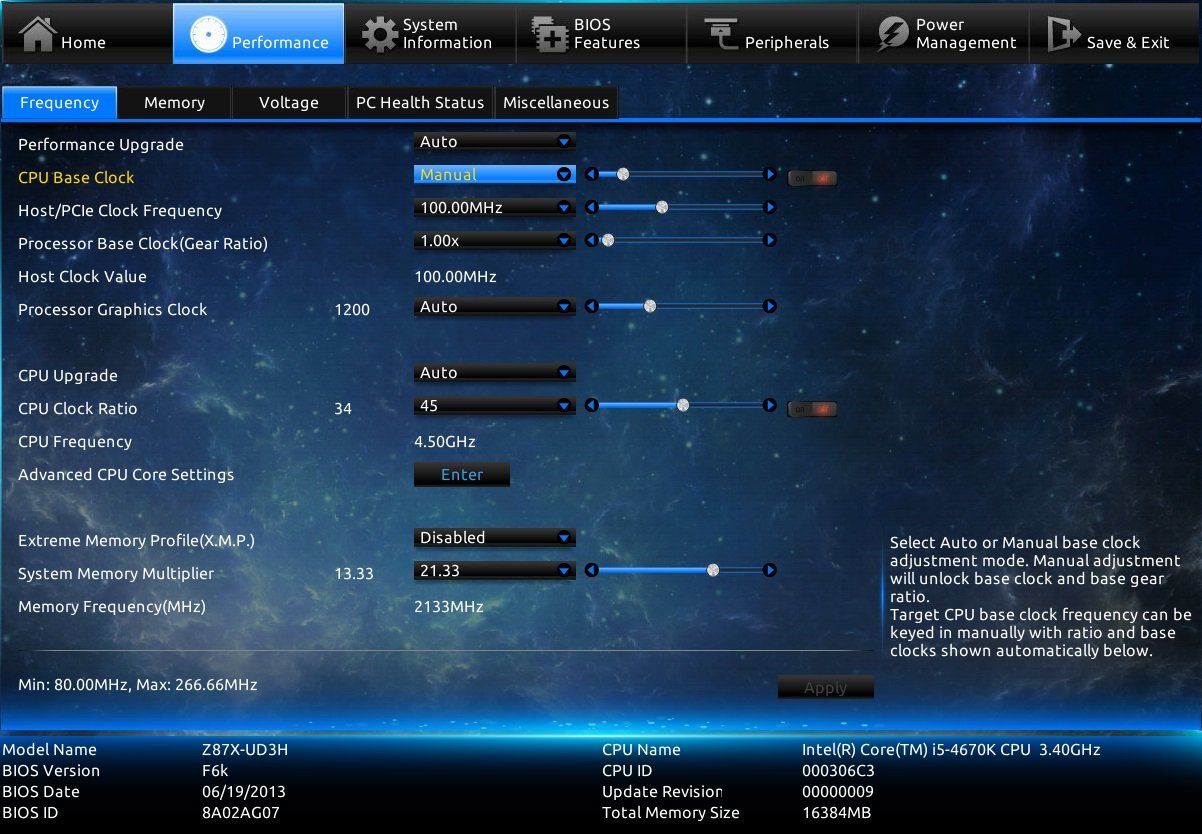
After we replace the CPU with a Core i5-4670, which has the same specs, we get fewer settings:
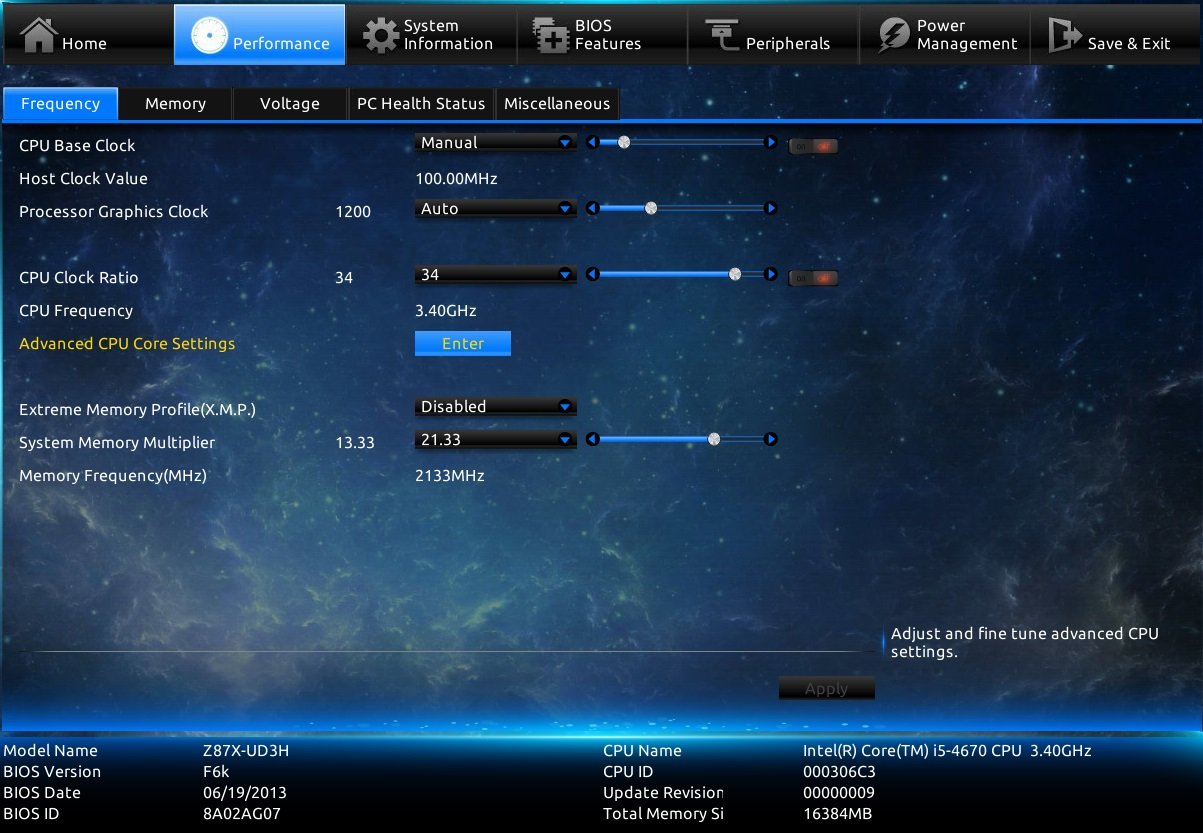
The options for increasing the CPU frequency multiplier above the standard level or for changing the base clock rate just vanish. So if you’ve got a non-overclocking Core i5 on your LGA1150 platform, you will only be able to overclock system memory and the integrated graphics core.
Conclusion
Although we’ve taken our first look at several Haswell-based Core i5 processors in this review, we don’t have much new data. These CPUs just have the same highs and lows as the Haswell-based Core i7 series we tested earlier.
To be specific, the new Core i5 4000 series are an average 5 to 10% faster than their 3000 series predecessors thanks to improvements in the Haswell microarchitecture. Their clock rates haven’t changed. We could also see that the new CPUs have high potential in the way of the new AVX 2.0 instruction set. AVX 2.0 is hardly used by existing software, but its universal adoption may make the Haswell much more attractive in the future.
That said, it is questionable whether the Core i5 4000 series are superior to their predecessor on all points. There are important consumer properties other than sheer performance, and the Haswell microarchitecture has certain problems in this respect.
The flagship model Core i5-4670K is indeed faster than any other Core i5 and can even challenge the heavyweight Core i7-3770K at single-threaded loads but its overclocking potential is lower even if compared with the Core i5-3570K. We could only overclock our Haswell to 4.5 GHz whereas same-class CPUs with Ivy Bridge design could be overclocked by 100-200 MHz more. Of course, the overclocked Core i5-4670K is still going to be a little faster thanks to its more progressive microarchitecture, but Haswell CPUs call for a new platform. You have to buy a new mainboard to use them. That’s why upgrading to the Core i5-4670K from an earlier Core i5 doesn’t make sense. You may only want to choose it if you’re building a completely new computer.
The midrange Haswell variants, Core i5-4670 and Core i5-4570, offer rather high performance as well, being occasionally faster than the Core i5-3570K. The problem is that Intel has prohibited overclocking them (and the rest of non-K Haswell-based CPUs) in the limited way which was possible before. It means the midrange Core i5 Ivy Bridge CPUs can easily be overclocked to 4.0 GHz whereas the new Core i5 series don’t offer such an opportunity.
The junior Haswell-based CPU available at the moment, Core i5-4430, looks very odd. It is comparable to the Core i5-3470 in price but nearly always inferior to it in performance. It can hardly be recommended even for completely new configurations. The time-tested LGA1155 platform would be a better choice.
Thus, the new Core i5 4000 series CPUs may only be really interesting in just a few scenarios. You may want to choose the Core i5-4670K if you want to build a new computer and overclock your CPU. Or you may want to choose the Core i5-4570 if you are not going to overclock your new computer and your CPU budget is limited to $200. Otherwise, preferring the Haswell and switching to the LGA1150 platform is hardly rational.
There is one important exception, though. We shouldn’t forget that the new microarchitecture features an improved integrated graphics core whose performance has grown much more than the x86 performance. We didn’t cover this issue in this review since we had tested the HD Graphics 4600 earlier. But if you need a hybrid processor with a fast x86 part and a functional graphics core, the Haswell is quite a good option.